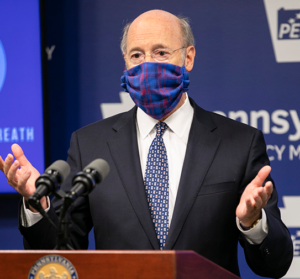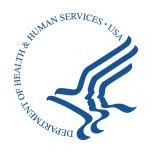The following is the latest COVID-19 information from the state and federal governments as of 2:30 p.m. on Tuesday, November 24.
Pennsylvania Update
 Governor Wolf/Department of Health
Governor Wolf/Department of Health
Citing modeling that projects 22,000 new COVID-19 cases a day in Pennsylvania in December, Governor Wolf and Department of Health Secretary Levine have introduced new mitigation efforts. The governor’s news release announcing these new efforts noted that “In the past week, the number of COVID-19 attributable deaths has quadrupled, and the average daily case count is 7 times higher than it was two months ago.”
The news release also explained that “The new measures include revamped school safety attestation, targeted business and gathering restrictions, and a new enforcement plan that includes liability protection for businesses enforcing the Secretary of Health’s strengthened mask-wearing order.”
The new mitigation effort also addresses elective procedures performed in acute-care hospitals. The order establishes criteria under which the Department of Health may order hospitals to reduce by 50 percent the number of elective procedures performed in their facilities for a period of seven days. Orders to reduce elective procedures can be triggered based on hospital staffing levels, COVID-19 surges, and available bed capacity. Such orders will apply to all acute-care hospitals in any region that meets two of the three metrics and will be in effect for seven days, with renewal possible depending on conditions within the region; regions are defined in the executive order. The order takes effect on November 30. See Secretary Levine’s order addressing required reduction of elective procedures in regions with low acute-care treatment capacity.
Department of Health
 The Department of Health announced that the federal government will be distributing supplies of the investigational monoclonal antibody therapy bamlanivimab to Pennsylvania hospitals. The state will decide which hospitals receive supplies, and in what quantities, based on county COVID-19 case counts. See the department’s news release for further information.
The Department of Health announced that the federal government will be distributing supplies of the investigational monoclonal antibody therapy bamlanivimab to Pennsylvania hospitals. The state will decide which hospitals receive supplies, and in what quantities, based on county COVID-19 case counts. See the department’s news release for further information.- The Department of Health has compiled answers to frequently asked questions on COVID-19 laboratory testing.
- The Department of Health strongly encourages the use of a COVID-19 safety pledge for nursing home residents who participate in non-medical outings during the holiday season. The pledge is meant to be a tool to educate residents, families, and friends about the additional risk of exposure when visiting the community.
Department of Health – by the numbers
 Pennsylvania’s number of COVID-19 cases today surpassed 321,000.
Pennsylvania’s number of COVID-19 cases today surpassed 321,000.- In three of the past ten days Pennsylvania has set a new single-day high for the number of new cases.
- Nearly 10,000 Pennsylvanians have now died from COVID-19.
- More than 32,000 residents of long-term-care facilities and more than 6000 people who work in those facilities have contracted COVID-19. Those figures encompass 1244 facilities in 64 of Pennsylvania’s 67 counties.
- More than 14,000 health care workers in the state have contracted COVID-19.
- The number of people currently hospitalized with COVID-19 has doubled in the past two weeks.
- The number of COVID-19 patients currently breathing with the help of a ventilator has doubled since November 5.
- Nearly 826 Pennsylvanians are currently in hospital intensive care units being treated for COVID-19; that is a 43 percent increase in the past week.
- 17 percent of hospital adult ICU beds are currently unoccupied, as are 17 percent of medical/surgical beds, 39 percent of pediatric beds, 19 percent of pediatric ICU beds, and 34 percent of airborne isolation unit beds. There are now more COVID-19 patients in adult ICU beds in Pennsylvania than there are currently unoccupied adult ICU beds in the state.
- The state-wide positivity rate on COVID-19 tests rose from 9.6 percent two weeks ago to 11.1 percent last week, according to the early warning dashboard released weekly by the governor and Department of Health. Sixty-six of Pennsylvania’s 67 counties have positivity rates greater than five percent.
- A positivity rate greater than five percent is considered “concerning,” Department of Health Secretary Levine has explained in the past.
- That same dashboard shows that 59 of the state’s 67 counties exhibited “substantial levels of community transmission” last week, down from 63 of 67 counties the previous week.
- In light of the growing number of COVID-19 cases, the Department of Health is now prioritizing case investigations. As a result, the number of successful contract-tracing efforts was down to 10 percent last week; it was 21 percent the previous week.
- Of the confirmed cases reported between November 8 and November 14 in which contact tracing was successful, 13 percent said they visited a business establishment 14 days prior to onset of symptoms (down from 19 percent two weeks ago). Among them:
- 48 percent reported going to a restaurant
- 24 percent reported going to some other business establishment
- 15 percent reported going to a bar
- 14 percent reported going to a gym/fitness center
- seven percent reported going to a salon/barbershop
In addition, 16 percent of respondents said they had attended a mass gathering or other large event 14 days prior to the onset of symptoms; two weeks ago, that figure was nearly 19 percent.
Federal Update
Provider Relief Fund
The Provider Relief Fund web page has been updated with the following notice:
The application deadline for the Provider Relief Fund Phase 3 General Distribution was Nov. 6, 2020. You must have submitted your Taxpayer Identification Number (TIN) for validation by 11:59 p.m. ET on Nov. 6, 2020 for Phase 3 relief funds. If you submitted your TIN for validation by the deadline and your TIN is validated by Nov. 13, you will be able to proceed with submitting your revenue documentation to complete your application by 11:59 p.m. ET on Nov. 27, 2020.
Department of Health and Human Services
 HHS has announced plans to allocate doses of the investigational monoclonal antibody therapeutics casirivimab and imdevimab for treatment of non-hospitalized patients with mild or moderate confirmed cases of COVID-19 at high risk of hospitalization; this is often referred to publicly as the Regeneron antibody cocktail. HHS will allocate 300,000 federally-purchased doses to state and territorial health departments that will determine which health care facilities receive the infusion drug. Weekly allocations of the drug will be proportionally based on confirmed COVID-19 cases in each state and territory over the previous seven days based on data that hospitals and state health departments enter into the HHS Protect data collection platform. Learn more from HHS’s announcement about the allocation plan. Find additional information about allocation here.
HHS has announced plans to allocate doses of the investigational monoclonal antibody therapeutics casirivimab and imdevimab for treatment of non-hospitalized patients with mild or moderate confirmed cases of COVID-19 at high risk of hospitalization; this is often referred to publicly as the Regeneron antibody cocktail. HHS will allocate 300,000 federally-purchased doses to state and territorial health departments that will determine which health care facilities receive the infusion drug. Weekly allocations of the drug will be proportionally based on confirmed COVID-19 cases in each state and territory over the previous seven days based on data that hospitals and state health departments enter into the HHS Protect data collection platform. Learn more from HHS’s announcement about the allocation plan. Find additional information about allocation here.- HHS has published a Request for Information notice in which it seeks to “…gather information on effective innovative approaches and best practices in health care in response to the COVID-19 pandemic by non-HHS health care systems and providers.” Comments are due by December 24. Go here to see the brief notice.
- HHS’s Office of the Assistant Secretary for Preparedness and Response has posted a paper on the designation of individual hospitals as COVID-19 hospitals within health systems or geographic areas.
- HHS’s Office of the Assistant Secretary for Preparedness and Response has posted a report on crisis standards of care and patient surge management for COVID-19.
- HHS’s Office of the Assistant Secretary for Preparedness and Response has posted a presentation with information on the use of point-of-care tests for the diagnosis of COVID-19.
Centers for Medicare & Medicaid Services
- CMS has posted the first episode in a series of short podcasts for frontline nursing home staff. The series, “CMS Beyond the Policy: Nursing Home Series for Frontline Clinicians and Staff,” is designed to reinforce training and infection control practices in nursing homes to help combat the spread of COVID-19. To listen to the podcast, go here.
Food and Drug Administration
 The FDA has issued emergency use authorization for emergency use of baricitinib (Olumiant), in combination with remdesivir (Veklury), for use by health care professionals in the treatment of suspected or laboratory-confirmed COVID-19 in certain hospitalized patients requiring supplemental oxygen, invasive mechanical ventilation, or extracorporeal membrane oxygenation (ECMO). See the FDA’s letter authorizing the drug’s use in this manner, a fact sheet for providers, and an FAQ on the emergency use of baricitinib in combination with remdesivir.
The FDA has issued emergency use authorization for emergency use of baricitinib (Olumiant), in combination with remdesivir (Veklury), for use by health care professionals in the treatment of suspected or laboratory-confirmed COVID-19 in certain hospitalized patients requiring supplemental oxygen, invasive mechanical ventilation, or extracorporeal membrane oxygenation (ECMO). See the FDA’s letter authorizing the drug’s use in this manner, a fact sheet for providers, and an FAQ on the emergency use of baricitinib in combination with remdesivir.- The FDA has issued an EUA for casirivimab and imdevimab to be administered together for the treatment of mild to moderate COVID-19 in adults and pediatric patients (12 years of age or older weighing at least 88 pounds) with confirmed cases of COVID-19 and who are at high risk for progressing to severe COVID-19. The FDA also posted an FAQ on the use of this combination of drugs.
- The FDA has approved an abbreviated new drug application for succinylcholine chloride injection, which can be used to facilitate tracheal intubation and provide skeletal muscle relaxation during mechanical ventilation for COVID-19 patients.
Centers for Disease Control and Prevention
- The CDC’s weekly morbidity and mortality report addresses the deliberations of the agency’s Advisory Committee on Immunization Practices’ ethical principles for the allocation of initial supplies of COVID-19 vaccine.
- The CDC has updated its information about strategies for optimizing providers’ supplies of N95 respirators.
- The CDC has updated its FAQs for laboratories that perform COVID-19 tests.
- The CDC has updated its guidance on infection control for nursing homes.
- The CDC also has updated its infection control assessment tool for nursing homes.
Department of Labor
- The Department of Labor’s Occupational Safety and Health Administration (OSHA) has updated its FAQ on the use of cloth face coverings as personal protective equipment.
Resources to Consult
Pennsylvania Department of Human Services
Pennsylvania Department of Health
Centers for Disease Control and Prevention